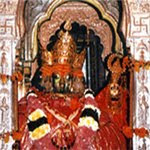Albert Hall
Albert Museum, Jaipur TravelsLocated just outside the walled city is the sprawling Ram Niwas garden, which has always been a place for recreational activities since the reign of Sawai Ram Singh ji . This exquisitely designed garden with forcentry doors and a huge complex with small pools and fountains, flourishing lawns and beautiful flower beds all around was basically a famine relief project. It mostly attracted the British families where they entertained their guest and families quite often with the lavish gowns of the Men and formal colourful attires of the nobels and the high society club members, this park would come alive with the setting sun.
Their individual 'BAGGIS' were parked outside in a line and the attendants served around as helpers. The children basically had a gala timely playing around in 'JHULAS'(swing) etc. During day time it was opened for the common public and by the evening it was opened for common public and by the evening it was available for exclusive lots. Situated in the middle of the garden as a centre attraction was the exquisitely built structure of Albert Hall, which was designed by sir Swinton Jacob, a British architect who designed many palaces in Rajasthan.
Combining the elements of English and north Indian architecture known as the pride of the New Jaipur opened in 1887 AD, it is a very well maintained and impressive building displaying a rich collection of Art- de- fact like paintings, carpet, ivory, stone and metal sculptures and colourful crystal works etc. Just opposite the Albert Hall is one of the oldest ZOO in the country, harbouring different species of birds and animals. Another piece of attraction near the Albert Hall, is the Ravindra Rang Manch (theatre) with a modern art gallery and an performing art theatre both indoor and open air. Recently added joints of interest are streets dotted with food stalls which promises a delicious variety of Indian fast food certainly relished by the tourists.
City Palace Museum
The art gallery is located in the Diwan-I-Aam, which literally mean the Hall of public audience. The exhibits here included some very precious and ancient handwritten original manuscripts of Hindu scriptures. Particularly intriguing in miniature copies of Bhagwat Gita made in this manner so that it can be concealed out of sight of Emperor Aurangzeb’s onslaught on Hindu scriptures. Some very delicate miniature paintings in Rajasthani, Mughal and Persian schools on various themes including the Ramayana are very engrossing displays. Visitors must also take a good at preserved painted ceilings. Also on display are elephant saddles called “haudha”.
Between the armoury museum and the art gallery is the Diwan-I-Khas meaning hall of private or selective audience. This is a marble paved pavilion and puts on display the world largest sterling silver object two gigantic silver vessels. These vessels were made for Maharaja Sawai Madho Singh II, who took in along with him filled with water from River Ganga for drinking. As a devout Hindu the Maharaja did not wish to risk polluted English waters. The ceiling also has large chandeliers, which are mostly protected by dust covers and opened only of festive occasions. The Guinness Book of Records accounts it has the biggest silver objects in the world.
The Chandra Mahal Palace is still occupied by the royal family but visitors can visit the ground floor where some exhibits are on display. However the visit here is worthwhile for the exquisite Peacock in the courtyard outside. The present day royal family that takes charge of the museum has done exceptionally well in preserving this legacy in fine state maintenance and presentation. A visits to the palace is enlightening one for its extraordinary occurrence.

